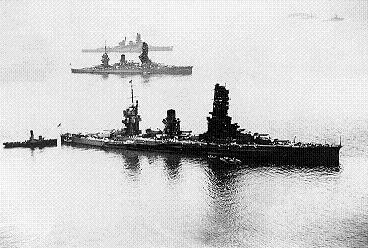![]() The Pacific War Online Encyclopedia
The Pacific War Online Encyclopedia
|
| Previous: Fushun | Table of Contents | Next: Futami Akisaburo |

Naval Historical Center #NH 90773
|
Tonnage |
34,700 tons standard displacement |
|
Dimensions |
698' by 100'6" by 31'9" 212.75m by 30.63m by 9.68m |
|
Maximum speed |
24.7 knots |
|
Complement |
1396 |
| 1 catapult 3 seaplanes |
|
|
Armament |
6x2 14"/45
guns 14x1 6"/50 guns 4x2 5"/50 dual-purpose guns 8x2 25mm/60 AA guns |
| 12,199 tons: 12" (305mm) VC belt tapering to 4" (102mm) 12" (305mm) bulkheads tapering to 4" (102mm) 8" (203mm) ship end belts tapering to 4" (102mm) 2.625" (67mm) NVNC on 1.25" (32mm) nickel steel armor deck 2" (51mm) ship end armor deck 3" (76mm) armor deck over steering compartment 8" (203mm) upper belt 5" (127mm) upper bulkheads 6" (152mm) casemate 0.6875"+0.6875" (17mm+17mm) HT weather deck 12"/8"/4.5" (305mm/203mm/114m) turret face/side/roof 12" (305mm) barbette 14" (356mm) conning tower |
|
| Machinery |
4-shaft Kampon geared turbines
(75,000 shp) 6 Kampon boilers |
|
Bunkerage |
5100 tons fuel oil |
|
Range |
8000 nautical miles (15,000km) at 14 knots |
| Modifications |
1941-12: 4 25mm
guns were added 1943-8: Fuso adds 8x3, 6x2 25mm guns, 10x1 13mm guns, and Type 13 and Type 22 radar (two sets each). Yamashiro removes one twin 25mm gun and adds 8x3, 7x1 25mm guns, 24x1 13mm guns, and Type 21 and Type 22 radar (two sets each.) 1944-10: Fuso adds 22x1 25mm guns. Yamashiro removes 14x1 13mm guns and adds 8x2, 10x2 25mm guns and 3x2 13mm guns. |
The Fusos
were
completed in 1915 and 1917 as superdreadnoughts, Fuso
at the Kure naval
yard and Yamashiro at the Yokosuka
naval
yard. The first major warships constructed entirely with Japanese
materials and weapons, they were ordered in response to the British Orion class, whose 13.5" (343mm)
guns reduced 12" (305mm) gun dreadnoughts to second class status.
The ships drew on the lessons of the Kongo
class battle cruisers, alongside which the new battleships were expected to fight, but
the designers deliberately chose lower-power machinery to make
room for a
heavier main armament. Protection was an improved version of that used
for the Kawachii class
dreadnoughts.
When commissioned, they were the largest and most heavily armed
battleships in the world, with a broadside that remained the heaviest
in the world until the completion of the Nagatos.
Both units were modernized in
1935, acquiring better deck armor
and antiaircraft
armament and much more powerful machinery. Torpedo blisters were also added.
The Fusos were still capable units at the outbreak of war, though less well protected than their American counterparts. Their 6” (152mm) secondary armament was useless against aircraft, and their pagoda superstructures made them about the ugliest battleships on the face of the planet, at least to Western eyes.
| Hashirajima | Sunk by gunfire and torpedoes 1944-10-25 at Surigao Strait | |
| Hashirajima | Sunk by gunfire and torpedoes 1944-10-25 at Surigao Strait |
References
CombinedFleet.com (accessed 2007-12-5)
Gogin (2010; accessed 2012-12-22)
Jentschura,
Jung, and Mickel (1977)
Whitley (1998)
The Pacific War Online Encyclopedia © 2007, 2009, 2013 by Kent G. Budge. Index